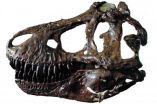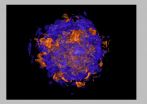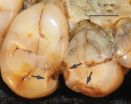(Press-News.org) VIDEO:
New imaging technique developed by cardiologist, Dr. James A. White and colleagues at The University of Western Ontario shows 3-D image of the heart vasculature and myocardial scar tissue.
Click here for more information.
Cardiologists and surgeons may soon have a new tool to improve outcomes for patients requiring pacemakers, bypass surgery or angioplasties. Research led by Dr. James White and his colleagues at The University of Western Ontario has led to a new imaging technique, which provides a single, 3D high-resolution image of the heart revealing both its vasculature and the presence of scar tissue within the muscle. This novel imaging was performed using a 3-Tesla MRI at Western's Robarts Research Institute. The findings are published on-line in the Journal of the American College of Cardiology: Cardiovascular Imaging.
Injuries to the heart, including heart attacks or viral inflammation, commonly result in permanent damage or scarring of its muscle. "We've known for some time that myocardial (heart) scar tissue can be imaged using MRI, but what we've now been able to do is to take this imaging to another level," explains Dr. White. "This is the first time we have been able to visualize myocardial scar and the heart's blood vessels at the same time. We are able to construct a three dimensional model of a person's heart to immediately understand the relationship between the heart's blood vessels and related permanent injury. This will help direct surgeons and cardiologists to better target the blood vessels that lead to muscle capable of responding to their therapy, rather than to muscle that is irreversibly diseased."
VIDEO:
This is a 3-D image of the heart vasculature and myocardial scar tissue (white) created using a new imaging technique with a 3-T MRI developed by cardiologist, Dr. James A....
Click here for more information.
The technique works by first acquiring a 3D coronary image using a continuous infusion of a contrast called gadolinium, which makes the blood-pool light up brightly. The 3-T MRI takes images as this contrast is infused into the blood stream, providing a high resolution, 3-D image of the heart showing coronary blood vessels. Scar tissue is slow to give up this contrast agent and its signal is therefore retained despite a washing out of contrast from the blood stream and normal tissues. A repeat image, performed 20 minutes later, highlights the heart's scar, also in 3D. Because the two images are taken in the identical way using the exact same MRI pulse sequence, they're already perfectly suited to be fused to one another. The result is a fused, 3D model of the heart that shows both the heart's vessels and scar tissue.
The imaging technique was performed on 55 patients referred for either bypass surgery or a specialized pacemaker designed to improve heart function called Cardiac Resynchronization Therapy (CRT), demonstrating that the procedure was clinically feasible. The study was able to demonstrate that this novel imaging technique may be valuable in the planning of these vascular-based cardiac interventions. Dr White describes that in bypass or angioplasty procedures surgeons have to decide whether or not to open up blocked blood vessels, but if they can see there is scar in that region, no benefit will be expected. Similarly, CRT pacemaker leads delivered to regions of scarred heart muscle may prevent any benefit from this therapy.
INFORMATION:
This research was funded by the Heart and Stroke Foundation of Ontario and the Canada Foundation for Innovation.
Dr. White is a Cardiologist and a scientist with Robarts and the Biomedical Imaging Research Centre at Western and Lawson Health Research Institute. He is an assistant professor in the Department of Medicine at the Schulich School of Medicine & Dentistry and practices within the Division of Cardiology at the London Health Sciences Centre.
Cardiac imaging breakthrough developed at the University of Western Ontario
2010-09-16
ELSE PRESS RELEASES FROM THIS DATE:
Discovery of key pathway interaction may lead to therapies that aid brain growth and repair
2010-09-16
WASHINGTON, DC—Researchers at the Center for Neuroscience Research at Children's National Medical Center have discovered that the two major types of signaling pathways activated during brain cell development—the epidermal growth factor receptor pathway and the Notch pathway—operate together to determine how many and which types of brain cells are created during growth and repair in developing and adult brains. This knowledge may help scientists design new ways to induce the brain to repair itself when these signals are interrupted, and indicate a need for further research ...
NASA's 3-D look into Hurricane Igor's heavy rainfall
2010-09-16
NASA's Tropical Rainfall Measuring Mission (TRMM) satellite has provided a 3-D look at the power "under the hood" (of clouds) in powerful Category 4 Hurricane Igor as it heads toward Bermuda. In the meantime, Igor is creating dangerous surf in the eastern Atlantic, and it will affect the U.S. East coast later today. Igor is an extremely dangerous category four hurricane on the Saffir-Simpson hurricane wind scale today, Sept. 16, and he is expected to remain a large and powerful hurricane over the next several days.
The TRMM satellite, operated by NASA and the Japanese ...
Scientific understanding of T. rex revised by a decade of new research and discovery
2010-09-16
We've all heard this story: the Late Cretaceous of Asia and North America—about 65 million years ago—was dominated by several large-headed, bipedal predatory dinosaurs like Tyrannosaurus rex and Tarbosaurus that had tiny arms. But a decade of new fossil discoveries that have more than doubled the number of known tyrannosaur species has changed this tale. Older and smaller tyrannosaurs have made the evolutionary tree of this group richer and more complex. Furthermore, a series of innovative research projects on topics like bone growth and biomechanics have added an enormous ...
Beating blood clots: Reducing your risk before hip replacement surgery
2010-09-16
Risk factors for venous thromboembolism after total hip replacement (THR) surgery were identified in a new study published in the September 2010 issue of The Journal of Bone and Joint Surgery (JBJS). While the rate of thromboembolism has been significantly reduced through medication, understanding the risk factors could further reduce the likelihood of patients developing this potentially fatal complication.
Two of the most common manifestations of a thromboembolism include:
Deep vein thrombosis (DVT), in which the blood clot forms in a deep vein, commonly in the thigh ...
Placebo effect significantly improves women's sexual satisfaction, study shows
2010-09-16
AUSTIN, Texas — Many women with low sex drives reported greater sexual satisfaction after taking a placebo, according to new psychology research from The University of Texas at Austin and Baylor College of Medicine.
The study was conducted by Cindy Meston, a clinical psychology professor at The University of Texas at Austin, and Andrea Bradford, a 2009 University of Texas at Austin graduate and postdoctoral fellow in the Department of Family and Community Medicine at Baylor College of Medicine. They found that opening a new line of communication about sex can have a positive ...
3-D computer simulations help envision supernovae explosions
2010-09-16
For scientists, supernovae are true superstars -- massive explosions of huge, dying stars that shine light on the shape and fate of the universe.
For a brief burst of time, supernovae can radiate more energy than the sun will emit in its lifetime. With the potential energy of 25 hundred trillion trillion nuclear weapons, they can outshine entire galaxies, producing some of the biggest explosions ever seen, and helping track distances across the cosmos.
Now, a Princeton-led team has found a way to make computer simulations of supernovae exploding in three dimensions, ...
Asthma and cavities both common in kids but not linked
2010-09-16
INDIANAPOLIS – There is no apparent link between asthma and tooth decay, according to a study published in the September 2010 issue of the Journal of the American Dental Association.
"Is There a Relationship between Asthma and Dental Caries?: A Critical Review of the Literature" examined the 27 separate studies which looked for a link between asthma and cavities that were reported in 29 papers published between 1976 and March 2010.
"The notion that there is a link between asthma and tooth decay may have its origin in anecdotal statements by emergency room workers who ...
Disease transmission model says media coverage cuts infection rate and pandemic extent
2010-09-16
At the first sign of a disease pandemic, public health officials should begin strongly communicating about the extent of the outbreak and the steps that can be taken by the public to avoid infection. That's the recommendation of two mathematical biologists who have modified the most widely used infectious disease transmission model to account for the impact of news media coverage.
During outbreaks of serious infectious diseases, many individuals closely follow media reports and as a result, take precautions to protect themselves against the disease. These precautions ...
October 2010 Lithosphere highlights
2010-09-16
Boulder, CO, USA – The October LITHOSPHERE examines the following key questions: (1) how do large volumes of silicic magma contribute to the growth of continental crust?; (2) how does the Tibetan Plateau grow?; (3) what are the dynamics of the lithosphere beneath the Eastern Carpathians in Romania?; (4) what's really true about the Mojave-Snow Lake fault hypothesis?; (5) can Earth's pulse be measured at its hotspots?; and (6) what is the nature of the Moho in NW Canada?
Keywords: Philipsburg Batholith, Tibetan Plateau, Carpathians, Mojave-Snow Lake fault, hotspots, Moho.
Highlights ...
A chip off the early hominin tooth
2010-09-16
Were our early mammalian ancestors vegetarians, vegans or omnivores? It's difficult for anthropologists to determine the diet of early mammalians because current fossil analysis provides too little information. But a new method that measures the size of chips in tooth fossils can help determine the kinds of foods these early humans consumed.
Prof. Herzl Chai of Tel Aviv University's School of Mechanical Engineering, in collaboration with scientists from George Washington University and the U.S. National Institute of Standards and Technology (NIST), has developed an equation ...





